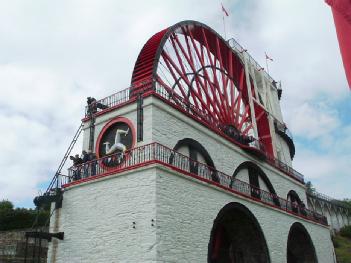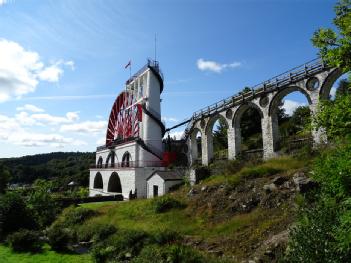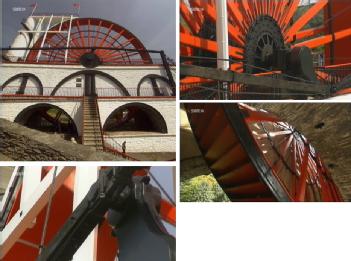| Description
|
In the 19th century, mining for lead and zinc began, becoming the largest industry the village has had. The Laxey mines were the deepest in the world in the 19th century.
Laxey Wheel, also known as Lady Isabella after the wife of The Hon. Charles Hope, then Lieutenant Governor of the Isle of Man, was built in 1854 to pump water from the Laxey mine shafts. Now a tourist attraction, it remains the largest working waterwheel in the world. Designed by Robert Casement, it is 72 feet 6 inches (22.10 m) in diameter and 6 feet (1.83 m) wide. It revolves at about 3 rpm. The mines employed over 600 miners at their peak, producing lead, copper, silver and zinc, until they closed in 1929. The Wheel was owned by Edwin Kneale from 1939 to 1965; he saved it from being dismantled and ran it as a tourist attraction, before passing it on to the Manx nation, with the agreement that it should be kept in perpetual running order for the people of the Isle of Man. In 1965 the Isle of Man Government bought the wheel and the site. Restoration work began, and in 1989 it was put under the control of Manx National Heritage.
A water-powered wheel was used to pump out the mines since the Isle of Man does not have a supply of coal for a steam-powered pump.
Water from the surrounding area – including the local river – is collected in a cistern, which is above the level of the top of the wheel. A closed pipe connects the cistern to the top of the wheel; thus the water flows up the tower without problem as an inverted syphon. The water falls from the pipe into the buckets (formed from wooden slats on the circumference) and makes the wheel rotate in what is described as the 'reverse' direction. The crank has a throw of 4 feet (1.22 m) and connects to a counterweight and to a very long rod. This rod runs along the rod viaduct to the pumping shaft where the 8 feet (2.44 m) stroke is converted by T-rockers into a pumping action.
Most of the wheel and rod is made of wood; however, key mechanical parts are metal to provide tension and bearing surfaces. The rod has attached wheels at intervals to permit the stroke's motion with minimal friction.
Dimensions
Diameter: 22m = 72 ft 6 in.
Circumference: 210 ft 6 in.
Width: 6 ft.
Delivery: 250 imperial gallons (1,100 l) of water a minute from the Laxey mines some 200 yards (180 m) away and 1,500 feet (460 m) below ground.
Mine
The mine employed over 600 miners at its peak producing lead, copper, silver and zinc until it closed in 1929. In 1965 the Manx Government bought the wheel and site. The wheel was restored and, in 1989, it was put under the control of Manx National Heritage.
Lissen Musikclip of the Laxey Wheel. It is the Chorus-part of the song, to find here. |

 mnh.gov.im
mnh.gov.im 


